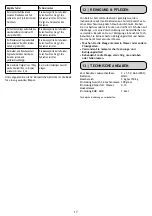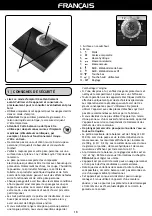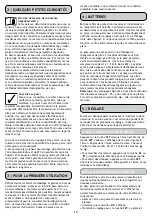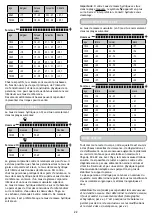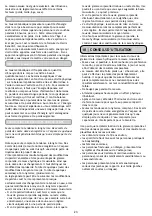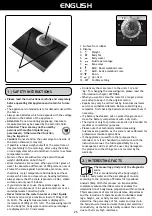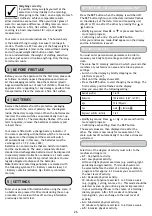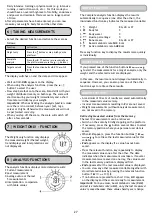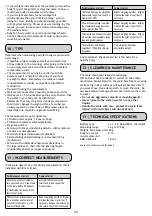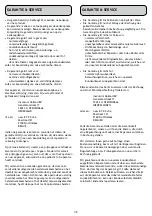
endurance athletes, however, the recommended values
could be exceeded due to low fat percentages and high
muscle percentage.
This scale is unsuitable for measuring body water in order
to draw medical conclusions concerning age-related water
retention, for example. If necessary ask your physician.
Basically, a high body water percentage should be the
aim.
Important:
If your body water proportion is rated as
poor, an symbol appears next to the interpretation
bar.
Tip: Increase your daily water intake.
The muscle percentage is normally within the following
ranges:
man
Age
low
normal
high
10-14
< 44
44 - 57
> 57
15-19
< 43
43 - 56
> 56
20-29
< 42
42 - 54
> 54
30-39
< 41
41 - 52
> 52
40-49
< 40
40 - 50
> 50
50-59
< 39
39 - 48
> 48
60-69
< 38
38 - 47
> 47
70-100
< 37
37 - 46
> 46
female
Age
low
normal
high
10-14
< 36
36 - 43
> 43
15-19
< 35
35 - 41
> 41
20-29
< 34
34 - 39
> 39
30-39
< 33
33 - 38
> 38
40-49
< 31
31 - 36
> 36
50-59
< 29
29 - 34
> 34
60-69
< 28
28 - 33
> 33
70-100
< 27
27 - 32
> 32
Like the rest of our body, our bones are subject to the
natural development, degeneration and ageing processes.
Bone mass increases rapidly in childhood and reaches its
maximum between 30 and 40 years of age. Bone mass
reduces slightly with increasing age. you can reduce
this degeneration somewhat with healthy nutrition
(particularly calcium and vitamin D) and regular exercise.
With appropriate muscle building, you can
also strengthen your bone structure.
note that this scale will not show you the calcium content
of your bones, but will measure the weight of all bone
constituents (organic substances, inorganic substances
and water).
Attention:
Please do not confuse bone mass with bone
density.
Bone density can be determined only by means of
a medical examination (e.g. computer tomography,
ultrasound). It is therefore not possible to draw
conclusions concerning changes to the bones and bone
hardness (e.g. osteoporosis) using this scale.
Little influence can be exerted on bone mass, but it
will vary slightly within the influencing factors (weight,
height, age, gender).
The basal metabolic rate is the amount of energy
required by the body at complete rest to maintain its
basic functions (e.g. while lying in bed for 24 hours). This
value largely depends on the weight, body size and age of
the individual and is displayed on the diagnostic scale in
Kcal/day units using the scientifically recognised Harris-
Benedict formula. your body requires this amount of
energy in any case and it must be reintroduced into your
body in the form of nutrition. Failing to supply the body
with the necessary amount of calorific energy can cause
serious health problems.
The active metabolic rate is the amount of energy
required daily by the body in its active state.
The energy consumption of a human being rises with
increasing physical activity and is measured on the
diagnostic scale in relation to the degree of activity
entered (1-5). To maintain your existing weight, the
amount of energy used must be reintroduced into the
body in the form of food and drink. If less energy is
introduced than is used over a longer period of time,
your body will obtain the difference largely from the
amount of fat stored and your weight will reduce. If, on
the other hand, over a longer period of time more energy
is introduced than the total active metabolic rate (Amr)
calculated, your body will be unable to burn off the
excess energy, and the excess will be stored in the body
as fat and your weight will increase.
Remember that only long-term trends are important.
Short-term fluctuations in weight over a few days are
usually the result of a loss of fluid.
The interpretation of the results will depend on changes
in your overall weight and body fat, body water and
muscle percentages, as well as on the period during which
these changes take place. rapid changes
within days must be distinguished from medium term
changes (over weeks) and long term changes (months).
A basic rule is that short term changes in weight almost
exclusively represent changes in water content, whereas
medium and long term changes may also involve the fat
and muscle percentages.
• If your weight reduces over the short term, but your
body fat percentage increases or remains the same, you
have merely lost water – e.g. after a training session,
sauna session or a diet restricted only to rapid weight
loss.
29
muscLe peRcentAge
bone mAss
bmR =
basal
metabolic
rate
AmR =
active
metabolic
rate
ResuLts in ReLAtion to time
Summary of Contents for PW 620 BM
Page 1: ...PERSONENWEEGSCHAAL PERSONENWAAGE P SE PERSONNE SCALE...
Page 2: ...2...
Page 31: ...31...
Page 34: ...34...
Page 35: ...35...



